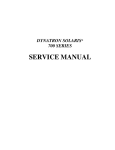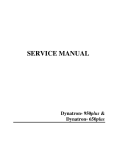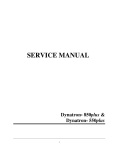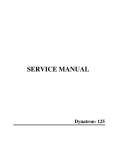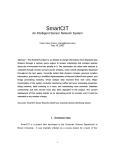Download Dolby Laboratories DA20 Instruction manual
Transcript
MODEL DA20 DIGITAL FILM SOUND PROCESSOR Users' Manual Issue 4 Part No. 91342 USERS' MANUAL FOR MODEL DA20 DIGITAL FILM SOUND PROCESSOR Dolby Laboratories Incorporated U.S.A. 100 Potrero Avenue, San Francisco, CA 94103 Tel: 415-558-0200; Fax: 415-863-1373 U.K. Wootton Bassett, Wilshire SN4 8QJ, England Tel: +44 (0)1793 842100; Fax: +44 (0)1793 842101 www.dolby.com WARRANTY INFORMATION—U.S.A.: warranty on the product covered by this manual is subject to the limitations and disclaimers set forth in the warranty disclaimer originally shipped with the product and also printed on the back of the invoice. All requests for repairs or information should include the unit serial number to ensure rapid service. Note: This equipment has been tested and found to comply with the limits for a Class A digital device, pursuant to Part 15 of the FCC Rules. These limits are designed to provide reasonable protection against harmful interference when the equipment is operated in a commercial environment. This equipment generates, uses, and can radiate radio frequency energy and, if not installed and used in accordance with the instruction manual, may cause harmful interference to radio communications. Operation of this equipment in a residential area is likely to cause harmful interference in which case the user will be required to correct the interference at his own expense. Digital decoding covered by the following U.S. patents: 4,790,016, 4,914,701, 4,799,260 4,941,177, 5,109,417, 5,142,656, 5,230,038, 5,274,740, 5,297,236, 5,357,594, 5,463,424, 5,583,962, 5,608,805, and other worldwide patents granted and pending. Dolby is a registered trademark of Dolby Laboratories. ©1997 Dolby Laboratories ISSUE 4 S97/10410/11548 Dolby Part No. 91342 i TABLE OF CONTENTS INTRODUCTION About this manual ........................................................................................................................................ ii About the Dolby DA20 and the Dolby Stereo Digital Format ............................................................... ii SECTION 1 OPERATING INSTRUCTIONS 1.1 1.2 1.3 1.4 1.5 1.6 1.7 How to Identify Sound Tracks on Prints ................................................................................. 1-1 Film Threading ............................................................................................................................ 1-2 Displays ........................................................................................................................................ 1-2 Format Control and Auto Digital Modes ................................................................................ 1-4 Single Projector Installations ..................................................................................................... 1-8 Two Projector Changeover Operation ..................................................................................... 1-8 Operation With an Automation System .................................................................................. 1-8 SECTION 2 MAINTENANCE AND ADJUSTMENTS 2.1 2.2 2.3 Digital Soundhead Maintenance .............................................................................................. 2-1 Print Cleanliness ......................................................................................................................... 2-2 Adjustments ................................................................................................................................. 2-2 SECTION 3 UNIT SERVICING/IN CASE OF DIFFICULTY APPENDIX A DA20 CIRCUIT BOARD LOCATIONS ii INTRODUCTION Thank you for purchasing the Dolby Model DA20 Digital Film Sound Processor. It combines the high performance for which all processors manufactured by Dolby Laboratories are well known with the latest digital technology to decode the Dolby Digital print format. About this manual This User’s Manual has been prepared specifically to help theater personnel get the most from the Model DA20 and Cat. No.700 Digital Soundhead after proper installation. Installation should be attempted only by qualified personnel. Installation and alignment instructions are provided in a separate manual. We suggest that you keep this manual readily available for quick reference. The manual is organized as follows: • Section 1, Operating Instructions, covers the basic control and indicator functions of the DA20, and is all you need to get the show started. • Section 2, Maintenance and Adjustments, contains tips for maintaining the DA20 and the Cat. No.700 Soundhead in your theater system. • Section 3, Troubleshooting, will help you track down problems in the digital sound system without test equipment. It consists of procedures to follow to isolate and fix simple problems. • Appendix A contains circuit board location information. For the sake of clarity, boldface type is used for all specific references to DA20 controls and indicators and their labels, such as Digital Signal Level, and CP Status. CP refers to Cinema Processor. In addition, indicator lights on the DA20 are referred to in the text as LEDs (Light-Emitting Diodes). About the Dolby DA20 and the Dolby Stereo Digital Format The Dolby Model DA20 enables Dolby models CP45, CP55, CP65, CP200 and CP500 Cinema Processors to play the Dolby digital soundtrack format. The Digital Film Sound System consists of a Cat. No.700 Digital Soundhead with cables and the Model DA20 Digital Film Sound Processor. An additional Cat. No.700 Digital Soundhead may be added for use in two projector changeover systems. The soundhead is a mechanical assembly which provides a stable film path, and uses a CCD array to scan digital data from a digital print. The DA20 decodes the scanned digital soundtrack into six channels of high quality audio. Among the features of the DA20 are: • Automatic format selection between a Dolby digital track and the conventional analog SR track. • Display of digital signal level. iii • Adjustable time delay for mounting the Cat. No.700 Digital Soundhead up to 135 frames in advance of the analog soundhead. • Adjustable surround delay to match theater size. • Simple interface to the Dolby Cinema Processors. • Comprehensive Cinema Processor status display. • Automatic switching to analog soundtrack in the event of damaged or missing digital data. The DA20 includes interface cables to mate with the required Cinema Processor type. Dolby Digital prints have conventional SR analog and digital tracks which enables lowcost 35mm optical prints to deliver the volume range, fidelity and discreteness previously associated only with 70mm releases. The Dolby Digital format utilizes an innovative digital encode/decode process, Dolby AC-3. The process translates five full range (20-20 kHz) channels plus a subwoofer audio channel and auxiliary data channel into a series of data blocks, printed between the perforations of standard 35mm film. On playback, the data blocks are scanned by an optical pickup head, and transformed back into full professional quality digital audio. Release prints in the Dolby Digital format also contain standard SR encoded Dolby Stereo analog tracks, resulting in single inventory prints and unprecedented quality and reliability in film audio presentation. This manual describes the operation of the DA20 when equipped with a Cat. No. 611A Cinema Processor Interface card. The Cat. No. 611A has features that were not available on the original Cat. No. 611. In particular, the automatic selection of Format 10 (Dolby Digital), Format 05 assertions after a power failure, and other improvements are now incorporated. Thus, the manual sections that describe the operation of auto digital and power failure format assertion are not applicable to those units which are equipped with the original Cat. No. 611 card. To determine if a Cat. No. 611A is installed in your unit, look through the CP Status opening on the DA20 front panel. If your unit is equipped with a Cat. No. 611A, you will see “CAT. NO. 611A” printed on the PC board just inside the window immediately below the “Analog” LED. Behind the text you will also see a cross hatched pattern printed on the board. These two markings indicate that your unit is equipped with a Cat. No. 611A. Your installer can provide details. If your unit is not equipped with a Cat. No. 611A, the switch positions for Auto Digital Disabled modes are not available and the CP Type is selected using positions 1 through 3 depending on which cinema processor is attached. See manual Section 1.4 a 1-1 SECTION 1 OPERATING INSTRUCTIONS 1.1 1.2 1.3 1.4 1.5 1.6 1.7 1.1 How to Identify Sound Tracks on Prints Film Threading Displays Format Control Single Projector Installations Two Projector Changeover Operation Operation With An Automation System How to Identify Sound Tracks on Prints A Dolby Digital film print or a stereo optical print (A-Type or SR), or a mono optical print should be identified as such on both the film can and leader. However, with handling the identification may be lost. If you are not sure if you have a stereo analog print, play a reel and find a section with music and/or effects only (on dialogue or narration, stereo soundtracks look much the same as mono soundtracks). Examine the soundtracks closely; on music and effects, the two soundtracks will appear to be different on a stereo print; on a mono print they are identical. If you specified a stereo print and received a mono print in error, be sure to check with your local exchange or the film distributor. a Digital Print The digital data blocks are clearly visible between perforations next to the analog track. The analog track is Dolby SR encoded. Analog Dolby Stereo Print Clear differences between channels will be seen in some places along the track. Mono Print Both tracks are the same. Figure 1.1 Film Sound Tracks There is no way to tell by visual inspection if a stereo print has been encoded with a surround channel or whether it is Dolby A-type or SR encoded. However, all but a few early Dolby Stereo releases do have a surround channel. The majority of prints are now Dolby SR encoded. If you are in doubt, play the print in format 04 Dolby A-type until you have a chance to listen to the track and compare playback quality in formats 04 and 05. 1-2 1.2 Film Threading The Cat. No. 700 Digital Soundhead is similar in many ways to a conventional analog soundhead, having a lightweight flywheel, toothed sprocket, two pad rollers, and two dashpot-damped tension arms. The pad rollers on the toothed sprocket are coupled to allow easy film threading. A spring loaded roller arm damps variations in input film tension. Bypass rollers are provided to bypass the soundhead with either 35 or 70 mm film. Figure 1.2 shows Digital Soundhead film path threading. Care must be taken to thread the film the same way every time, so that the distance from the optical pickup point to the film gate is constant from show to show. Circuitry in the DA20 processor delays the signal read at the optical pickup by an amount set during installation. The threading must match this delay, or improper synchronization will result. NOTE: Film tension is important. A proper loop is set when the tension arms match the white half circles. The arms must not touch, or be too far apart (Approximately 5mm is correct). Set film path so that top and bottom tension arm rollers A are approximately 5 MM (1/4 inch) apart. Use the white painted semi-circles B for angular alignment of tension arms C . Make sure that the rollers do not touch. C B A A B C Digital Print Threading Path Bypass Threading Path Figure 1.2 Film threading 1.3 Displays The DA20 has eight slots in the front panel to allow sets of LEDs to be visible, indicating the activity of various circuits. The large slot in the center is used as an error rate display on a seven segment LED. Six of the slots show digital audio signal level, and the last shows Cinema Processor Status. Each area will be discussed below. 1-3 Error Rate Display 1 = CP55 Auto Digital 2 = CP45/65/500 Auto Digital 3 = CP200 Auto Digital 5 = CP55 Auto Digital Disabled 6 = CP45/65/500 Auto Digital Disabled 7 = CP200 Auto Digital Disabled Cinema Processor Type Switch Output Signal Present Indicators L C R LS RS SW Fixed Delay 100 perf 10 perf 1 perf S SR D digital analog +10 +1 -1 -40 +10 +1 -1 -40 L R +10 +1 -1 -40 +10 +1 -1 -40 +10 +1 LS -1 -40 +10 +1 RS -1 -40 Digital Status Indicators C.P. Status C SW proj 1 motor 1 proj 2 motor 2 Proj C/O and Motor Running Indicators Power - 15 +15 +5 Digital Signal Level Power Rail Indicators Surround Delay X 10ms Digital Signal Level Indicators Figure 1.3 DA20 Front Panel Error Rate Display Following powerup, with no film running, the seven-segment display will display a “-” indicating no data on which to display error rate. When film is run, the display will show error rate of the film on a scale of 0-8 with intermediate values indicated by the right hand decimal point (0,0.,1,1.,2,2.,3,3.,4,4.5,5.,6,6.,7,7.,8,) where 0 is the lowest and 8 is the highest. The display shows “F.” when an uncorrectable block is being processed. Digital Signal Level Display Digital audio signal levels are displayed for channels Left, Right, Left Surround, Right Surround, Center and Subwoofer using four LEDs for each channel. The bottom LED in each set shows audio activity less than –40dB below Dolby Digital level. Equal brightness of the center two LEDs indicates “Dolby Digital level”, corresponding to an 85dB SPL in the theater. The top LED indicates activity greater than +10dB above Dolby level when lit. These LEDs show that digital audio from a Dolby Digital print is being decoded. Signal Present Indicators Signal Present Indicators are active when the signal level is approximately –40dB or above (with respect to Dolby Digital Level). The LED brightness corresponds directly to signal level. These Indicators represent the decoded analog signal level present at the output of the DA20. In a system using a CP200 Cinema Processor, analog audio from the cinema processor is routed through the DA20 to allow switching between the analog and the digital tracks. The LEDs indicate the decoded digital signal level when the digital status Indicators show that a digital track is selected, and the analog signal level when analog track is indicated (see Digital status below). In a system using other Dolby cinema processors, audio switching between analog and digital is performed within the Cinema Processor, and the LEDs will reflect only decoded digital signal level. 1-4 Digital Status Indicators These LEDs indicate the format of the audio coming from the DA20. When the upper (green) LED is on, Format 10 has been selected, and the DA20 is producing decoded digital audio. When the lower (yellow) LED is on, Format 10 has been selected but the DA20 is unable to decode digital information from the film (either the film is not a Dolby Digital print, or the data is unreadable) and has switched to the analog track. When neither LED is on, a format other than 10 has been selected, and the digital audio track is not being reproduced. Projector Changeover and Motor Running Indicators The Projector1 and Projector2 LEDs indicate the status of the changeover line from the Cinema Processor. Motor1 and Motor2 LEDs indicate which projector motor(s) are running. The motor running signals are used in the timing of changeovers in a two projector system. Power Rail Indicators These LEDs indicate the presence of the three power supply rails in the DA20. All three should be lit when power is applied to the DA20. Front Panel Switches The five rotary switches shown on the DA20 front panel are for use by technicians when the DA20 is first installed and adjusted. Changing the delay switches requires the use of special test equipment. Do not arbitrarily adjust these switches. 1.4 Format Control and Auto Digital Modes The DA20 can operate in either of two basic modes: Auto Digital and Auto Digital Disabled. These are described below: Auto Digital—When the CP Type switch (See figure 1.3) is set to positions 1, 2 or 3, depending on the cinema processor type, the DA20 will switch the cinema processor to Dolby Digital, Format 10, under certain conditions. Auto Digital Disabled—When the CP Type switch is set to position 5, 6 or 7, depending on the cinema processor type, the format selection is controlled by the Cinema Processor alone and the DA20 will assert no formats except when playing digital audio and a reversion is required. Details of operation differ depending on the type of Cinema Processor used and are described later. When Format 10, Dolby Digital, is selected, the DA20 will output digital audio whenever it is available. When the DA20 is playing digital audio, the green ‘Digital’ LED on the DA20 front panel will light. When digital audio is not available (for example, while playing an analog only film), the DA20 will switch the cinema processor to Format 05, Dolby SR, if Format 10 was selected previously. If the Dolby Digital track becomes corrupted beyond correction through perforation damage, then error concealment techniques are applied for up to 4 perforations (40ms). If the data is still unreadable, the DA20 then switches the Cinema Processor to Format 05 (Dolby SR). This is referred to as a ‘reversion to analog’ or simply ‘reversion’. Reversion is indicated on the front panel of the DA20 when the yellow ‘Analog” LED lights. This 1-5 LED will also light if the cinema processor is in Format 10 and an analog only film is played. In order for the DA20 to switch the cinema processor back to Format 10 after a reversion, the digital track must become correctable after a damaged section of film has passed, or an un-damaged digital track must be played after an analog-only film. At this point, the DA20 will switch the cinema processor back to Format 10 and the green “Digital” LED will again light. The operation of the DA20 with each Cinema Processor is described separately below: CP55 When the CP Type switch is set to position 1, the DA20 will operate in CP55 Auto Digital mode. In this mode, the DA20 will automatically switch the CP55 to Format 10 if the following conditions exist: • The DA20 detects that the CP55 is in a film format (01, 04, or 05). • Dolby Digital audio is available. • No format buttons are pressed. If all of the above conditions exist, then the DA20 will automatically switch the CP55 to Format 10, eliminating the need to cue Dolby Digital films or trailers. If a film format button is pressed on the CP55 after the DA20 has automatically switched to Format 10, the DA20 will switch the CP55 back to Format 10 after the button is released to keep the CP55 in Format 10 as long as Dolby Digital audio is available. If digital audio is no longer available, the DA20 will cause a reversion and switch the CP55 to Format 05. During a reversion, any format can be selected on the CP55 and the DA20 will not assert any formats. However, if the CP55 is in a film format and digital audio again becomes available, the DA20 will switch the CP55 back to Format 10. There are two methods by which to disable the automatic selection of Format 10. First, the user can rotate the CP Type switch (see figure 1.3) to position 5. This disables the ability of the DA20 to assert any format commands except those associated with reversions (i.e. Format 05 when valid digital is lost and Format 10 when valid digital returns). In emergency situations, the user can press and hold the Format 05 button on the CP55 for at least 4 seconds. After 4 seconds has elapsed, the green ‘Digital” LED on the DA20 will go out. At this point, the CP55 will be in Format 05. Any format can be selected on the CP55 front panel without the DA20 forcing the CP55 back into Format 10. Format 10 can again be selected from the CP55 and the DA20 will go into Format 10. To re-enable the automatic selection of Format 10 after it has been disabled by pressing the Format 05 button for 4 seconds, either the DA20 must be turned off and then on again, or the CP Type selector switch must be rotated out of and back into position 1. CP45/CP65/CP500 When the CP Type switch (see figure 1.3) is set to position 2, the DA20 will operate in CP45/CP65/CP500 Auto Digital mode. In this mode, the DA20 will automatically switch the CP45/CP65/CP500 to Format 10 if the following conditions exist: 1-6 • The DA20 detects that the CP45/CP65/CP500 is in a film format (01, 04, or 05). • Dolby Digital Audio is available. • No format buttons are pressed. If all of the above conditions exist, then the DA20 will automatically switch the cinema processor to Format 10, eliminating the need to cue Dolby Digital films or trailers. Exception - CP45s built before mid-1997: The DA20 will not automatically switch the CP45 into Format 10 if Format 01 (mono) has been selected. If all of the above conditions exist, then the DA20 will automatically switch the CP45/ CP65/CP500 to Format 10, eliminating the need to cue Dolby Digital films or trailers. If a film format button is pressed on the CP45/CP65/CP500 after the DA20 has automatically switched to Format 10, the DA20 will switch the CP45/CP65/CP500 back to Format 10 after the button is released to keep the CP45/CP65/CP500 in Format 10 as long as Dolby Digital audio is available. If digital audio is no longer available, the DA20 will cause a reversion and switch the CP45/CP65/CP500 to Format 05. During a reversion, any format can be selected on the CP45/CP65/CP500 and the DA20 will not assert any formats. However, if the CP45/CP65/CP500 is in a film format and digital audio again becomes available, the DA20 will switch the CP45/CP65/CP500 back to Format 10. There are two methods by which to disable the automatic selection of Format 10 on the CP45/CP65 and one method on the CP500. These are described below: CP45/CP65/CP500: The user can rotate the CP Type switch to position 6, CP45/CP65/ CP500 Auto Digital Disabled mode. This disables the ability of the DA20 to assert any format commands except those associated with reversions (i.e., Format 05 when valid digital is lost and Format 10 when valid digital returns). CP45/CP65 only: In emergency situations the user can press and hold the Format 05 button on the CP45/CP65 for at least 4 seconds. After 4 seconds has elapsed, the green ‘Digital” LED on the DA20 will go off. At this point, the CP45/CP65 will be in Format 05. Any format button on the cinema processor can be pressed without the DA20 forcing the CP45/CP65 back into Format 10. Format 10 can again be selected from the CP45/CP65 and the DA20 will go into Format 10. To re-enable the automatic selection of Format 10 after it has been disabled by pushing the Format 05 button for 4 seconds, either the DA20 must be turned off and then on again or the CP Type selector switch must be rotated away from and back to position 2. CP200: In order for the CP200 Auto Digital mode to operate, the DA20 must be connected to the CP200 using a Cat493 Auto Digital Interface board and cable assembly. Since Format 10 can reside on any of the four format selectors on the CP200, the operation of the DA20 with this Cinema Processor is different from the above mentioned processors. When power is first applied to the DA20 with the CP Type switch (see figure 1.3) set to position 3 (CP200 Auto Digital mode), the DA20 will sequentially select formats A through D on the CP200, looking for Format 10. The DA20 will scan the four format selectors up to 10 times. If Format 10 is found on one of the format selectors, the DA20 1-7 will remember which format selector is set to Format 10 and will select this format whenever the CP200 is in any film format and valid digital audio is. If Format 10 is not detected on one of the format selectors, the DA20 will operate in Auto Digital Disabled mode. Once this occurs, if the user wishes to enable the Auto Digital mode, one of the CP200 format selectors must be programmed to Format 10 and the CP Type switch on the DA20 must be rotated out of and then back into position 3. This will cause the DA20 to again scan the CP200 format selectors. As soon as the DA20 detects Format 10 on one of the format selectors, it will stop scanning the CP200 format selectors, and begin Auto Digital operation. In either case, the CP200 will be left in whatever format is selected by selector D, regardless of the wakeup format chosen on the CP200. If Format 10 is detected on one of the format selectors, the DA20 will automatically assert that format whenever the following conditions are met: • The DA20 detects that the CP200 is in Format 01, 04, or 05. • Digital audio is available. If all of the above conditions exist, the DA20 will automatically assert Format 10 thus eliminating the need to cue Dolby Digital films or trailers. If a different film format is selected on the CP200 while valid digital audio is available, the DA20 will again select Format 10 to keep the CP200 in Format 10. After the DA20 has switched the CP200 to Format 10, if valid digital audio is no longer available, the DA20 will cause a reversion. Though the format selector on the CP200 which is programmed to Format 10 will remain selected, the yellow ‘Analog” LED will light and the audio signal path will switch to the analog SR track. At this point, an automation system or operator can assert any format. The DA20 will not re-assert Format 10 until digital audio is again available. To disable the automatic selection of Format 10 by the DA20, two methods are provided in CP200 installations. First, the CP Type switch can be set to position 7 (CP200 Auto Digital Disabled). This disables the ability of the DA20 to assert any format commands except those associated with analog reversions when in Format 10. In emergency situations , the ‘GO’ button on the CP200 can be pressed and held for at least 4 seconds. After 4 seconds has elapsed, the green ‘Digital” LED on the DA20 will go off and the ‘Analog’ LED will flash. At this point, the CP200 will be playing the analog SR track and any format can be selected without the DA20 forcing the CP200 back into Format 10. If Format 10 is again selected, the DA20 will remain in analog mode thus forcing the CP200 to play the analog SR track. Auto-digital mode can not be re-enabled unless the DA20 is turned off and then on again or the CP Type switch is rotated out of and back into position 3. This will cause the DA20 to re-scan the CP200 format selectors and look for Format 10 again and therefore should not be done while film is playing. 1-8 1.5 Single Projector Installations In single projector installations, the Proj 1 motor start input is normally grounded with a jumper. Presence of this conection is shown by a continuously illuminated Proj 1 led on the Cat. No. 611. If this connection is not present, a fault in the digital data will not cause the system to switch to analog; it will just go silent. For this reason it is very important to jumper pin 1 to pin 5 on the motor start connector J9 in a single projector system. 1.6 Two Projector Changeover Operation The DA20 “changes over” between Cat. No.700 Digital Soundheads by switching between digital data signals at a time in advance of the actual picture changeover. The data on the film is read by the Digital Soundhead ahead of the picture gate by typically 1-1/2 seconds. A delay circuit in the DA20, set during installation, compensates for this “early” reading of data. In order for a changeover to be seamless, the switchover to the incoming digital data must happen “early” as well. The Motor Start signal (a contact which closes when power is applied to the projector) is used to initiate the digital changeover. Digital changeover occurs at eight seconds minus the amount of delay set at installation. Eight seconds is the time between the motor start cue at the end of a reel and the last picture frame on that reel. If the Digital Soundhead were located at the analog soundhead position, no fixed delay would be required, and the digital changeover would happen simultaneously with the picture changeover. Any amount of delay added to the digital signal to compensate for “early reading” (ahead of the analog soundhead) must be subtracted from the 8 seconds to get the time that the digital signal must be switched after the motor start. 1.7 Operation With an Automation System The DA20 may be used in conjunction with any standard automation system, but the following guidelines must be followed: To select Dolby Stereo Digital, format 10 must be selected. If no valid digital data is present, either due to an analog only print or to problems reading the digital track, the DA20 Cinema Processor system will automatically switch to format 05, Dolby SR. When used with a CP45, CP55, CP65, or CP500, the automation system must use momentary Cinema Processor format select lines. The DA20 senses and controls these lines to switch between digital and analog as required. If format lines are held continuously, incorrect operation will result, and this situation will need to be corrected. When used with a CP200 Cinema Processor, the automation system controls the Cinema Processor. It, in turn, sends a signal to the DA20 indicating that digital sound is desired. The DA20 responds with a green LED located on the DA20 front panel indicating that digital audio has been decoded and is present on its output lines. If valid digital data is not available, a yellow LED will be on. 2-1 SECTION 2 MAINTENANCE AND ADJUSTMENTS 2.1 2.2 2.3 2.1 Digital Soundhead Maintenance Print Cleanliness Adjustments Digital Soundhead Maintenance The Cat. No.700 Digital Soundhead should be kept clean and free of dust and dirt for best performance, just like your analog soundhead. Wiping the external surfaces with a clean cloth on a regular basis will keep the head looking new. The optical path should be inspected regularly and kept clean with a photographer’s lens cleaning kit (available from most camera stores). Use care not to scratch the lens. The film path (rollers and drum) should be cleaned regularly, as you would on the projector. No acetone, carbon tetrachloride, or other dangerous cleaners should be used. Replacing the Exciter Lamp The exciter lamp in your Cat. No.700 Digital Soundhead has been designed for long life and should provide over 8000 hours of reliable use under normal circumstances. Routine replacement will depend on your theater’s hours of operation. To replace the exciter lamp, carefully remove the six screws holding the rear cover/power supply of the Digital Soundhead. Allow the lamp to cool if necessary. With the rear cover removed, the lamp will be visible but still attached to the rear cover assembly by its two supply wires. Slide the lamp out of its base. Carefully remove a new lamp from the protective box, and using gloves or a clean, lint-free cloth, replace the lamp in the socket. Be careful not to touch the bulb or inner surface of the reflector in the lamp. If either is accidentally touched, carefully clean the area with isopropyl alcohol when the bulb is cool. Slide the lamp back into its base in the soundhead, replace the rear cover assembly and tighten the six screws. Replacement lamp: Use only General Electric EPT Reflector-type 42W Dolby Part No. 34010 Figure 2.1 Digital Soundhead Exciter Lamp Replacement 2-2 2.2 Print Cleanliness As with any soundtrack, keeping the print clean will give best performance. The Dolby Digital print format has robust error correction information encoded along with the audio data, and the DA20 uses a powerful digital error correction technique, allowing the data to be read perfectly even if scratches and dirt are present. However, best performance will be obtained if the print is kept clean. Standard film cleaners will provide good results. The sound quality of the digital track has properties unlike those of an analog track with regard to print wear. With any analog track, print wear will degrade quality in a more or less linear fashion; the more wear, the lower the quality of the sound. With a digital soundtrack, wear will have no audible effect until the picture quality is degraded beyond use. At this point, wear may exceed the error correction capabilities of the decoder, and switching to the analog track will occur. DIGITAL ANALOG (Sound & Picture) Quality Number of plays 2.3 Adjustments Routine adjustments are not required on the DA20 under normal use. Adjustments for cinema processor type, soundhead delay, surround delay, focus, and film path alignment are made during installation, and should not be attempted by the operator. Small adjustments may not affect the sound under most circumstances, and no changes will be heard, but improper adjustment may reduce the safe operating area within which all errors can be corrected. Proper test equipment is required. Refer to the DA20 Installation manual for further information. Caution: There are no user serviceable parts inside the DA20. To avoid electric shock, do not attempt any repairs. Refer all servicing to qualified personnel. 3-1 SECTION 3 UNIT SERVICING / IN CASE OF DIFFICULTY 3.1 Troubleshooting During the Show Your theater sound system consists of a number of critical audio components in addition to the Dolby DA20 system. Thus, the first step when something goes wrong with the sound is to find the source of the problem. The troubleshooting chart for your cinema processor can be very helpful. If indications are that the fault lies in the DA20, the procedures in the following paragraphs may be useful. If you are unable to solve the problem using the information which follows, call your service engineer. If he or she is unavailable, you may also call Dolby Laboratories’ 24 hour emergency number in San Francisco for expert advice: (415) 558-0200. You will be asked to leave your name and number, and a Dolby Engineer will call you back promptly. 1. If Digital Sound is Lost • Switching to the analog track will occur if the Digital Soundhead is playing film which is not in Dolby Digital format, or if the digital blocks have become unreadable due to an obscured optical path or print damage. If frequent switching occurs, check for print and optical path cleanliness. • Check to make sure power is supplied to the DA20 processor chassis and the Digital Soundhead exciter lamp. • If power is present at the Digital Soundhead, but the exciter lamp is not lit, the lamp needs to be replaced. Refer to page 2-1 for information on replacing the exciter lamp. • If you are sure that power is applied to the DA20, but no LEDs on the front panel are on, check the fuse in the power entry module on the rear of the DA20. If it appears blown, replace with a spare fuse of the type and value specified on the rear panel of the DA20. • Check the video cable(s) from the Digital Soundhead(s) to the DA20 and make sure both ends are properly attached. • If the Auto Digital feature is enabled, disable it using the following method: CP45 / CP55 / CP65—If the Auto Digital feature is enabled, disable it using the following method: CP200—Press and hold the “GO” button on the CP200 for at least 4 seconds. The “Digital” LED on the DA20 will go off. CP500—Rotate the CP Type switch located on the DA20 front panel to position 6. 3-2 2. If One Channel Fails or is Distorted This is unlikely to be a fault of the DA20. Check for analog audio path continuity. If the problem is isolated to the DA20, contact your authorized Service Engineer. 3. If Switching to Analog Does Not Restore Sound If switching to analog occurs when in Format 10 (indicated by the yellow Analog LED on the DA20 front panel), but no analog sound is heard, FIRST select Format 05 (SR) by means of the Cinema Processor format selector switches. If this doesn’t work, remove power to the DA20 and reselect Format 05. 4. If Difficulty with Changeover is Experienced Correct changeover operation relies on installation of two relays which close sets of contacts when each projector motor is running. The normally open (closed when projector is running) contacts on these relays must be attached to connector J9 on the rear panel of the DA20. (Refer to Installation manual for further information.) In addition, a changeover signal from the Cinema Processor must be present and connected to the DA20. Correct operation of these signals may be observed by monitoring the Proj1, Motor1, Proj2, and Motor2 LEDs on the front panel of the DA20. 5. If Synchronization is Lost Synchronization of the digital soundtrack with the picture requires that the film path from the Soundhead to the picture gate be the same every time the projector is threaded. If two projectors are used, the path lengths must be identical. Digital Soundhead delay is set by switches on the Cinema Processor Interface Card (Cat. No.611A). If synchronization becomes incorrect during a show, press Format 10. This re-sends a delay turn-on command to the Cat No. 611A. If this does not solve the problem, then play the rest of the show in Analog, Format 05, and when time permits, run a loop of Cat. No.1010 Digital Soundhead Test Film and adjust the delay as described in Section 3. If none of the above techniques solves your problem, make sure the Cinema Processor is not in format 10, and try cycling the power to the DA20. This will reset the DA20 and may cure a transitory problem. A-1 APPENDIX A DA20 CIRCUIT BOARD LOCATIONS 670 671 671 673 674 675 686 611A Caution: Remove power before removing or inserting circuit boards. (Left to right, facing front of DA20): Slot Number 1 2 3 4 5 6 7 8 9 10 11 12 13 14 15 16 17 18 19 20 21 Cat. No. 670 671 671 673 674 675 686 611A Description Empty reserved reserved reserved reserved reserved reserved reserved reserved reserved reserved Video Front End board Dual DSP board Dual DSP board System Services board LED board (mounted on 675) AC-3 decoder DSP board Hex DAC board CP Interface board Empty Empty In the Cat. 700 Digital Soundhead: Cat. No.634 CCD (Charge Coupled Device) board



















